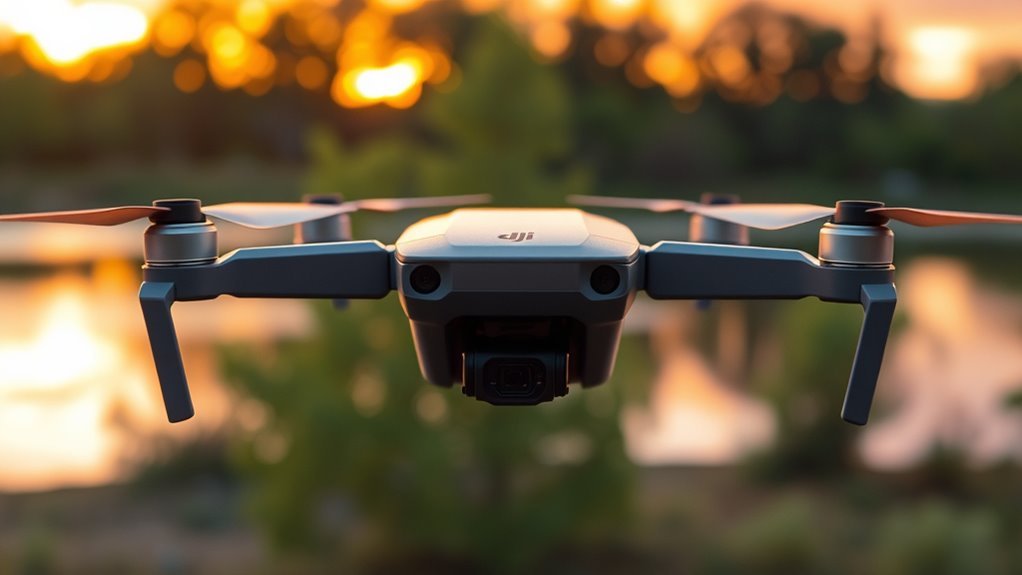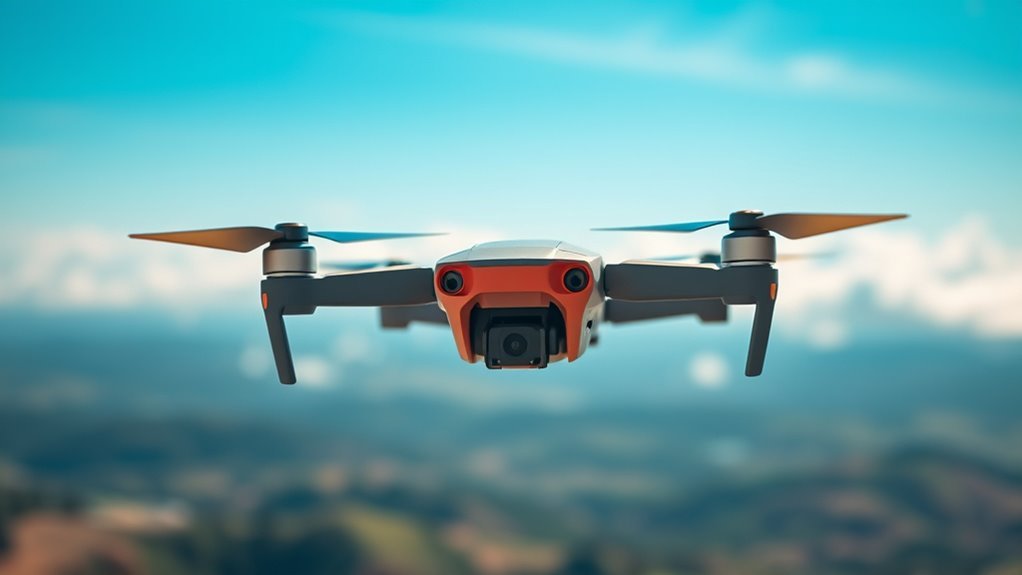You’ll find the DJI Spark mini drone offers a compact, durable design paired with stable flight performance and responsive controls. Its 12MP camera delivers solid images and smooth 1080p videos, supported by intelligent flight modes like gesture control and obstacle avoidance for added safety. Battery life lasts about 16 minutes, balancing portability with functionality. While not perfect in strong winds or low light, it’s a reliable choice for casual aerial photography. Explore further to understand how it measures up against other mini drones.
Design and Build Quality

Although the Dji Spark Mini Drone is compact, its design doesn’t compromise on durability or functionality. You’ll appreciate how the design aesthetics blend sleekness with purposeful structure, making it both visually appealing and practical. The drone’s material quality reflects a high standard, using lightweight yet robust plastics that endure minor impacts and resist wear. This careful balance guarantees you can carry it freely without worrying about damage. The drone’s compact frame also enhances portability, aligning with your desire for unrestricted exploration. Every curve and joint is engineered for resilience, maintaining structural integrity without adding bulk. This focus on design aesthetics and material quality means you get a device that’s not only attractive but built to support your freedom to fly anywhere confidently.
Flight Performance and Stability

When you pilot the Dji Spark Mini Drone, you’ll notice its impressive flight performance, which combines agility with reliable stability. The drone responds swiftly to your controls, demonstrating excellent flight agility that lets you maneuver through tight spaces and execute smooth turns effortlessly. Its stability systems work constantly to counteract wind resistance, ensuring steady hover and precise positioning even in moderately breezy conditions. This balance between responsiveness and steadiness gives you the freedom to explore with confidence, knowing the drone won’t easily falter. However, in strong winds, you might find its performance slightly challenged, though still manageable. Overall, the Spark’s flight dynamics offer a dependable and engaging experience, making it ideal for those seeking both control and freedom during flight.
Camera and Image Quality

Since capturing high-quality images is a key function of any drone, the Dji Spark Mini Drone offers a 12-megapixel camera equipped with a 1/2.3-inch CMOS sensor. You’ll appreciate its mechanical gimbal that provides effective image stabilization, ensuring sharp photos and smooth video footage even during flight. However, in low light conditions, image quality can degrade, with increased noise and reduced detail. The camera supports 1080p video recording at 30 fps, suitable for casual aerial videography. Below is a concise comparison of key camera specifications:
| Feature | Specification | Impact on Usage |
|---|---|---|
| Sensor Size | 1/2.3-inch CMOS | Balances detail & size |
| Resolution | 12 MP | Sharp still images |
| Video Recording | 1080p at 30 fps | Smooth video capture |
| Image Stabilization | Mechanical gimbal | Reduces motion blur |
| Low Light Performance | Moderate | Noticeable noise increase |
This setup offers freedom to capture quality imagery with some limitations in dim environments.
Intelligent Flight Modes
The Dji Spark Mini Drone offers several intelligent flight modes designed to enhance your control and creative possibilities. Among these, smart tracking lets you effortlessly follow moving subjects, maintaining focus while freeing you from manual piloting. This mode is particularly useful when capturing dynamic scenes, providing smooth, precise footage. Gesture control further simplifies operation by allowing you to command the drone using hand signals—launch, land, or take photos without a remote. This intuitive interaction grants you more freedom to engage with your surroundings while directing the drone. Together, these intelligent flight modes enable a seamless blend of autonomy and user input, empowering you to capture complex shots with ease and expand your creative horizons without being tethered to traditional controls.
Battery Life and Charging
You’ll notice the DJI Spark’s flight time is limited to around 16 minutes per battery, which requires careful planning during use. Charging efficiency also plays an essential role, as a full recharge takes roughly an hour, impacting overall readiness for extended sessions. Understanding these factors helps you manage your drone’s operational time effectively.
Flight Duration Limits
One of the key considerations when using the Dji Spark Mini Drone is its flight duration, which is largely dictated by battery life and charging times. The drone’s battery capacity directly influences its maximum flight time, which tops out at around 16 minutes under ideal conditions. This limited flight time means you’ll need to plan your flights carefully, especially if you want to capture extended footage or explore wider areas. While the compact battery capacity guarantees the drone remains lightweight and portable, it also imposes natural limits on continuous use. Understanding these constraints helps you balance your desire for freedom with practical usage, allowing for strategic flight sessions that maximize your experience without overextending the drone’s power reserves.
Charging Time Efficiency
Charging the Dji Spark Mini Drone’s battery typically takes around 80 minutes, a factor that directly impacts how quickly you can get back in the air after a flight. Efficient charging time optimization is essential if you want to maximize your flying freedom without long downtimes. While the drone’s battery capacity limits continuous flight duration, a quick recharge cycle minimizes waiting time, letting you plan multiple flights in a day more effectively.
| Aspect | Details |
|---|---|
| Charging Time | ~80 minutes |
| Battery Capacity | 1480 mAh |
| Quick Recharge Support | Yes, with optional charger |
| Impact on Flight Plans | Enables multiple flights |
Understanding these details helps you balance flight time and charging intervals smartly for greater flexibility.
Controller and App Interface
You’ll notice the controller’s compact design balances portability with functional precision, featuring responsive joysticks and intuitive buttons. The accompanying app enhances your experience by offering streamlined controls and customizable settings, making it straightforward to navigate flight modes. Together, these elements create a cohesive interface that supports both beginners and more experienced pilots.
Controller Design Features
The controller for the Dji Spark Mini Drone combines ergonomic design with intuitive functionality, ensuring a seamless user experience whether you’re a novice or an experienced pilot. Its compact form fits comfortably in your hands, reducing fatigue during extended flights. The layout prioritizes easy access to essential controls without crowding, allowing you to maintain focus on flying. Control responsiveness is particularly precise; the joysticks deliver smooth and immediate feedback, giving you confident maneuverability in tight spaces or open skies. Additionally, the controller integrates a quick-launch button and customizable settings, enhancing your flight freedom without unnecessary complexity. Overall, the thoughtful ergonomics paired with responsive controls empower you to pilot with both accuracy and comfort, revealing the full potential of the Spark Mini Drone.
App Usability and Functions
Although the controller offers tactile precision, much of the Dji Spark Mini Drone’s advanced functionality is accessed through its dedicated app, which seamlessly connects user commands with drone performance. The app’s user interface is intuitive, allowing you to quickly navigate complex settings without losing focus on flight freedom. Its app features enhance control, providing real-time telemetry and easy access to customizable flight modes. You’ll appreciate how the interface supports smooth shifts between manual and automated controls, empowering creative exploration.
Key app features include:
- Live HD video streaming for immersive piloting
- Intelligent flight modes like QuickShot and TapFly
- Extensive battery and signal status indicators
- Simple firmware updates and calibration tools
This app interface guarantees you retain full command without sacrificing ease-of-use or flight autonomy.
Portability and Storage
Compact design plays an essential role in how easily you can transport and store the Dji Spark Mini Drone. Weighing just under 300 grams, its compact design guarantees it fits effortlessly into backpacks or small carrying cases, enhancing travel convenience. You won’t need bulky storage solutions or extensive packing time, allowing you to bring it along on spontaneous adventures. The foldable arms further reduce its footprint, making it even more manageable when space is limited. This streamlined form factor doesn’t compromise functionality but supports your desire for freedom by enabling quick deployment wherever you are. Whether hiking, city exploring, or beachside flying, the Spark’s portability means it’s ready when you are, without burdening your gear or travel plans.
Safety Features and Reliability
You’ll want to assess the Spark’s collision avoidance system to understand how effectively it prevents crashes during flight. Equally important is evaluating the battery performance, not just for flight time but also for safety under different conditions. Together, these factors determine how reliable and secure the drone is during operation.
Collision Avoidance System
Maneuvering tight spaces or crowded environments demands a reliable collision avoidance system, and the DJI Spark addresses this with its front-facing obstacle sensors. These sensors rely on advanced sensor technology for accurate obstacle detection, allowing you to confidently navigate without constant manual corrections. While the system primarily scans ahead, it considerably reduces collision risks during forward flight. However, you should remain cautious as it lacks side and rear sensors, limiting thorough protection.
Key features include:
- Front-facing infrared sensors for real-time obstacle detection
- Automatic flight adjustments to avoid detected obstacles
- Sensor integration with flight control for smooth responsiveness
- Limitations in sensor coverage requiring user vigilance
This balance of technology and user control guarantees safer flight, enhancing your freedom to explore without sacrificing safety.
Battery Performance and Safety
Although flight time is a critical factor for any drone, the DJI Spark’s battery performance balances duration with safety features designed to protect both the device and its user. Its lithium-polymer battery technology offers about 16 minutes of flight, optimized through smart power management to prevent overheating and overcharging. You’ll appreciate built-in safeguards like short-circuit protection and temperature monitoring, which enhance reliability during your flights. To maximize battery lifespan and guarantee consistent performance, following maintenance tips is essential—store batteries at moderate temperatures, avoid full discharges, and use the official charger. By understanding these aspects, you can confidently enjoy extended freedom in the air without compromising safety or risking sudden power loss, making the DJI Spark a dependable companion for your aerial adventures.
Comparison With Other Mini Drones
When comparing the DJI Spark to other mini drones, it’s important to contemplate factors such as camera quality, flight time, and ease of control. You want a device that balances user experience with current market trends, ensuring both innovation and reliability. The Spark stands out, but it’s wise to assess alternatives to make an informed choice.
- Camera resolution: Spark offers 12MP, competitive yet some models provide 4K video.
- Flight time: Approximately 16 minutes, slightly below some rivals offering up to 20 minutes.
- Control methods: Gesture and smartphone control enhance freedom compared to basic remotes.
- Portability: Compact design fits easily in your gear, matching market expectations for mini drones.
This comparison helps you select a drone that aligns best with your desire for flexibility and performance.
Value for Money and Final Thoughts
Evaluating the DJI Spark’s features alongside its price reveals how well it balances cost with performance. When you conduct a value comparison, the Spark stands out for offering advanced capabilities like gesture control, stabilized 12MP camera, and compact design—all at a mid-range price point. For those weighing budget considerations, it delivers a compelling package without the steep costs associated with higher-end drones. While it may lack some professional-grade features, its ease of use and portability cater perfectly to users craving freedom and spontaneity. Ultimately, you get solid flight performance and intuitive controls that justify the investment. If you want a dependable mini drone that blends accessibility with quality, the DJI Spark represents a smart choice in its class.

